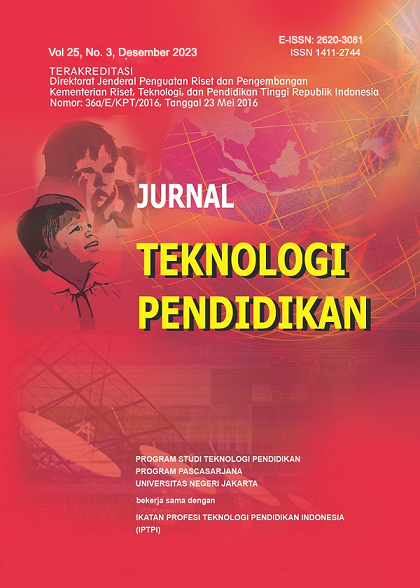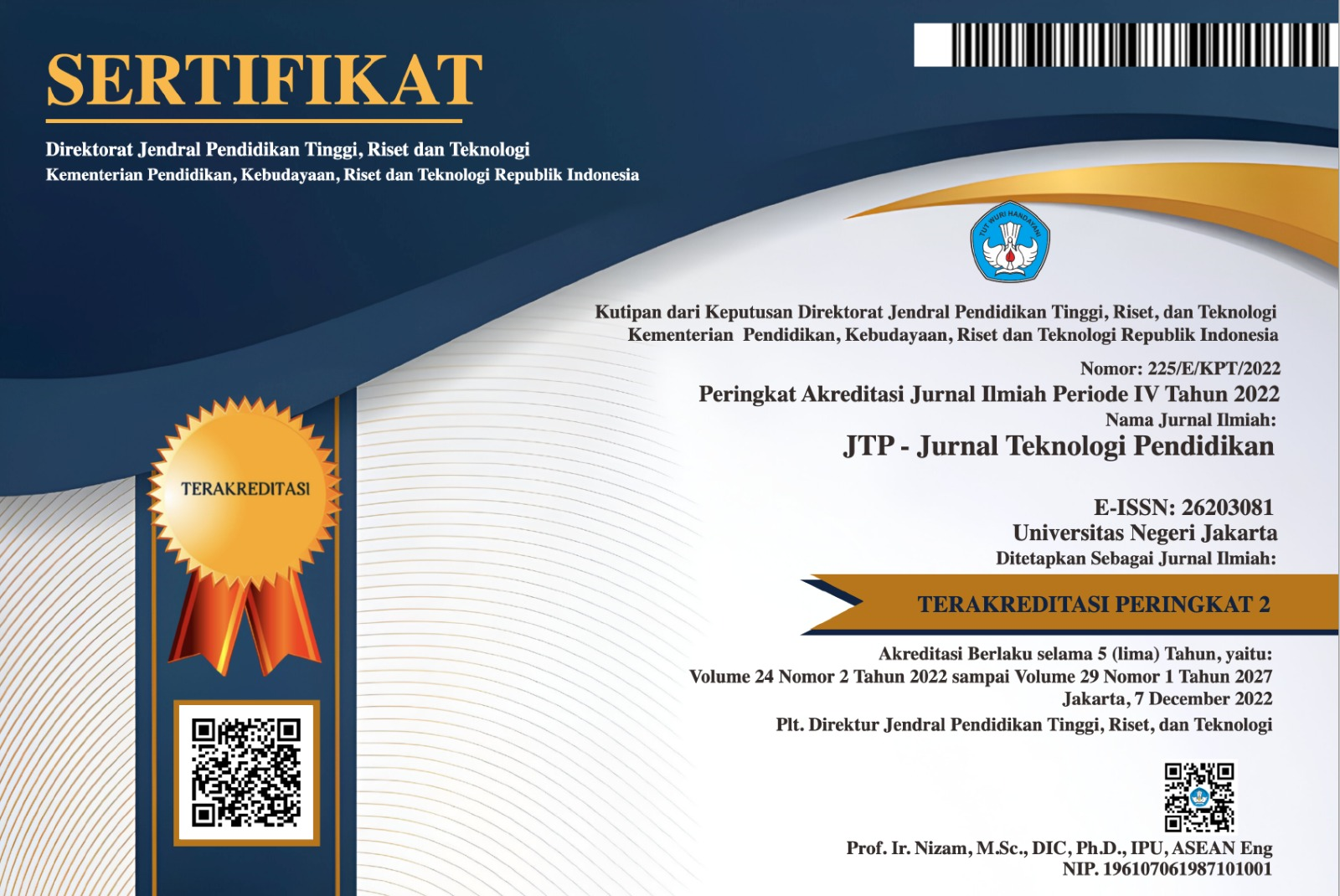Ability to Solve Complex Social Problems of Prospective Teachers according to Gender and Computational Thinking
DOI:
https://doi.org/10.21009/jtp.v25i3.38749Keywords:
Computational Thinking, Gender, Social problemAbstract
Entering the 21st century, computational thinking has become a basic skill that all students must have. This research aims to determine gender differences in learning outcomes to solve social problems, differences in students' levels of computational thinking by gender, and the influence of students' levels of computational thinking on learning outcomes in solving social problems. This research uses a descriptive verification method with a quantitative analysis approach. The number of research subjects was 256 students, who came from the Faculty of Teacher Training and Education, Sebelas Maret University. The quantitative data analysis used is based on the results of computational thinking ability tests using the Wilcoxon Test. Further analysis of this research uses K-Means for clustering, while analysis of the relationship between variables uses Spearman's rho. This research shows that there is an influence of gender on learning outcomes for solving social problems, there is no significant relationship between students' level of computational thinking and gender, and there is a significant influence of students' level of computational thinking on learning outcomes for solving social problems. The results of this research show that the two factors above play a large role in influencing student learning outcomes. This capability works in synergy with the computational level of thinking. With the right efforts, growing computational thinking skills can improve students' ability to solve various learning problems.
References
Alfonseca, E., Carro, R. M., Martín, E., Ortigosa, A., & Paredes, P. (2006). The impact of learning styles on student grouping for collaborative learning: A case study. User Modeling and User-Adapted Interaction. https://doi.org/10.1007/s11257-006-9012-7
Anderson, L. W., & Krathwohl, D. R. (2001). A Taxonomy for Learning, Teaching , and Assessing : A Revision of Bloom' s Taxonomy of Educational Objectives. Spring.
Angeli, C., & Georgiou, K. (2023). Investigating the effects of gender and scaffolding in developing preschool children's computational thinking during problem-solving with Bee-Bots. Frontiers in Education, 7(January), 1–12. https://doi.org/10.3389/feduc.2022.757627
Angeli, C., & Valanides, N. (2020). Developing young children's computational thinking with educational robotics: An interaction effect between gender and scaffolding strategy. Computers in Human Behavior, 105(January), 105954. https://doi.org/10.1016/j.chb.2019.03.018
Avcı, C., & Deniz, M. N. (2022). Computational thinking: early childhood teachers' and prospective teachers' preconceptions and self-efficacy. Education and Information Technologies. https://doi.org/10.1007/s10639-022-11078-5
Behlol, M. G., & Dad, H. (2010). Concept of Learning. International Journal of Psychological Studies, 2(2). https://doi.org/10.5539/ijps.v2n2p231
Bell, S. (2010). Project-Based Learning for the 21st Century: Skills for the Future. The Clearing House: A Journal of Educational Strategies, Issues and Ideas, 83(2), 39–43. https://doi.org/10.1080/00098650903505415
Carro, R. M., & Sanchez-Horreo, V. (2017). The effect of personality and learning styles on individual and collaborative learning: Obtaining criteria for adaptation. IEEE Global Engineering Education Conference, EDUCON. https://doi.org/10.1109/EDUCON.2017.7943060
Chacón-López, H., & Maeso-Broncano, A. (2023). Creative development, self-esteem and barriers to creativity in university students of education according to their participation in artistic activities. Thinking Skills and Creativity, 48(April 2022). https://doi.org/10.1016/j.tsc.2023.101270
Chongo, S., Osman, K., & Nayan, N. A. (2020). Level of Computational Thinking Skills among Secondary Science Student: Variation across Gender and Mathematics Achievement. Science Education International, 31(2), 159–163. https://doi.org/10.33828/sei.v31.i2.4
de Paula, B. H., Burn, A., Noss, R., & Valente, J. A. (2018). Playing Beowulf: Bridging computational thinking, arts and literature through game-making. International Journal of Child-Computer Interaction, 16, 39–46. https://doi.org/10.1016/j.ijcci.2017.11.003
Espino, E. E. E., & González, C. G. (2016). Gender and computational thinking: Review of the literature and applications. ACM International Conference Proceeding Series, 6–7. https://doi.org/10.1145/2998626.2998665
Ghosh, R., Rude-Parkins, C., & Kerrick, S. A. (2012). Collaborative problem-solving in virtual environments: Effect of social interaction, social presence, and sociability on critical thinking. In The Next Generation of Distance Education: Unconstrained Learning. https://doi.org/10.1007/978-1-4614-1785-9_13
Gu, Y. (2012). Learning strategies: Prototypical core and dimensions of variation. Studies in Self-Access Learning Journal, 3(4), 330–356.
Hamilton-Ekeke, J.-T. (2015). Improving Self-Regulated Learning Style amongst Students. International Journal of Secondary Education, 3(6), 72. https://doi.org/10.11648/j.ijsedu.s.2015030601.12
Harangus, K., & Kátai, Z. (2020). Computational thinking in secondary and higher education. Procedia Manufacturing, 46(2019), 615–622. https://doi.org/10.1016/j.promfg.2020.03.088
Heer, R. (2012). A model of learning objectives. In Center for Excellence in Learning and Teaching.
Hsu, P., Van Dyke, M., & Smith, T. J. (2017). The Effect of Varied Gender Groupings on Argumentation Skills among Middle School Students in Different Cultures. Middle Grades Review, 3(2), 1–22. https://doi.org/10.1007/s11307-018-1199-6
Jiang, S., & Wong, G. K. W. (2022). Exploring age and gender differences of computational thinkers in primary school: A developmental perspective. Journal of Computer Assisted Learning, 38(1), 60–75. https://doi.org/10.1111/jcal.12591
John Lemay, D., Basnet, R. B., Doleck, T., Bazelais, P., & Saxena, A. (2021). Instructional interventions for computational thinking: Examining the link between computational thinking and academic performance. Computers and Education Open, 2, 100056. https://doi.org/10.1016/j.caeo.2021.100056
Jones, B. D., Epler, C. M., Mokri, P., Bryant, L. H., & Paretti, M. C. (2013). The Effects of a Collaborative Problem-based Learning Experience on Students' Motivation in Engineering Capstone Courses. Interdisciplinary Journal of Problem-Based Learning, 7(2), 5–16. https://doi.org/10.7771/1541-5015.1344
Korkmaz, Ö., & Bai, X. (2019). Adapting computational thinking scale (CTS) for chinese high school students and their thinking scale skills level. Participatory Educational Research, 6(1), 10–26. https://doi.org/10.17275/per.19.2.6.1
Korkmaz, Ö., Çakir, R., & Özden, M. Y. (2017). A validity and reliability study of the computational thinking scales (CTS). Computers in Human Behavior, 72, 558–569. https://doi.org/10.1016/j.chb.2017.01.005
Laal, M., & Ghodsi, S. M. (2012). Benefits of collaborative learning. Procedia - Social and Behavioral Sciences. https://doi.org/10.1016/j.sbspro.2011.12.091
Lilian, A. (2022). Motivational beliefs, an important contrivance in elevating digital literacy among university students. Heliyon, 8(12), e11913. https://doi.org/10.1016/j.heliyon.2022.e11913
Lodi, M., & Martini, S. (2021). Computational Thinking, Between Papert and Wing. 883–908.
Mohd, N. I., Ali, K. N., Ebrahimi, S. S., & Ahmad Fauzi, A. F. A. (2019). Understanding the Level of Self-Directed Learning and Decision-Making Style of Construction-Related Workers. International Journal of Interactive Mobile Technologies (IJIM), 13(07), 44. https://doi.org/10.3991/ijim.v13i07.10749
Moon, B. (2014). The literacy skills of secondary teaching undergraduates: Results of diagnostic testing and a discussion of findings. Australian Journal of Teacher Education, 39(12), 111–130. https://doi.org/10.14221/ajte.2014v39n12.8
Moon, J., Do, J., Lee, D., & Choi, G. W. (2020). A conceptual framework for teaching computational thinking in personalized OERs. Smart Learning Environments, 7(1). https://doi.org/10.1186/s40561-019-0108-z
Pritchard, A. (2009). Ways of Learning. In The Lancet (Vol. 246, Issue 6365). https://doi.org/10.1016/S0140-6736(45)91319-5
Purnama, S., Wibowo, A., Narmaditya, B. S., Fitriyah, Q. F., & Aziz, H. (2022). Do parenting styles and religious beliefs matter for child behavioral problem? The mediating role of digital literacy. Heliyon, 8(6). https://doi.org/10.1016/j.heliyon.2022.e09788
Rosali, D. F., & Suryadi, D. (2021). An Analysis of Students' Computational Thinking Skills on The Number Patterns Lesson during The Covid-19 Pandemic. Formatif: Jurnal Ilmiah Pendidikan MIPA, 11(2), 217–232. https://doi.org/10.30998/formatif.v11i2.9905
Santosa, E. B., Degeng, I. N. S., Sulton, & Kuswandi, D. (2020). The effects of mobile computer-supported collaborative learning to improve problem solving and achievements. Journal for the Education of Gifted Young Scientists. https://doi.org/10.17478/jegys.656642
Santosa, E. B., & Sarwanta, S. (2021). Pengaruh Tingkat Internet Self-Efficacy, Pengalaman Mengajar dan Usia Guru Terhadap Peguasaan Komputer dalam Strategi Pembelajaran Daring. Jurnal Pendidikan Edutama, 8(1), 41. https://doi.org/10.30734/jpe.v8i1.1489
Selby, C., & Woollard, J. (2016). The Developing Concept of Computational Thinking. Informatics in Education, October 2018, 1–3.
Shanmugam, L., & Nadesan, G. (2019). An Innovative Module for Learning Computational Thinking Skills among Undergraduate Students. International Journal of Academic Research in Progressive Education and Development, 8(4), 116–129. https://doi.org/10.6007/ijarped/v8-i4/6440
Sola, E., Hoekstra, R., Fiore, S., & McCauley, P. (2017). An Investigation of the State of Creativity and Critical Thinking in Engineering Undergraduates. Creative Education, 08(09), 1495–1522. https://doi.org/10.4236/ce.2017.89105
Sovey, S., Osman, K., & Matore, M. E. E. M. (2022). Gender differential item functioning analysis in measuring computational thinking disposition among secondary school students. Frontiers in Psychiatry, 13(November), 1–14. https://doi.org/10.3389/fpsyt.2022.1022304
Tsai, M. J., Liang, J. C., & Hsu, C. Y. (2021). The Computational Thinking Scale for Computer Literacy Education. Journal of Educational Computing Research, 59(4), 579–602. https://doi.org/10.1177/0735633120972356
Varela, C., Rebollar, C., García, O., Bravo, E., & Bilbao, J. (2019). Skills in computational thinking of engineering students of the first school year. Heliyon, 5(11). https://doi.org/10.1016/j.heliyon.2019.e02820
Yadav, A., Gretter, S., Good, J., & Mclean, T. (2017). Emerging Research, Practice, and Policy on Computational Thinking. Emerging Research, Practice, and Policy on Computational Thinking, November. https://doi.org/10.1007/978-3-319-52691-1
Yuzela, A., Kristiyanto, A., & Riyadi, S. (2023). The Effect of Audio and Audio Visual Imagery Exercises on the Level of Creativity of Aerobic Gymnastics Instructors. International Journal of Human Movement and Sports Sciences, 11(2), 292–298. https://doi.org/10.13189/saj.2023.110205
Zapletal, A., Wells, T., Russell, E., & Skinner, M. W. (2023). On the triple exclusion of older adults during COVID-19: Technology, digital literacy and social isolation. Social Sciences and Humanities Open, 8(1), 100511. https://doi.org/10.1016/j.ssaho.2023.100511
Zimmerman, B. J. (1989). A Social Cognitive View of Self-Regulated Academic Learning. Journal of Educational Psychology. https://doi.org/10.1037/0022-0663.81.3.329
Downloads
Published
How to Cite
Issue
Section
License
Jurnal Teknologi Pendidikan is an Open Access Journal. The authors who publish the manuscript in Jurnal Teknologi Pendidikan agree to the following terms.
Attribution-ShareAlike 4.0 International (CC BY-SA 4.0)
-
Attribution — You must give appropriate credit, provide a link to the license, and indicate if changes were made. You may do so in any reasonable manner, but not in any way that suggests the licensor endorses you or your use.
-
ShareAlike — If you remix, transform, or build upon the material, you must distribute your contributions under the same license as the original.
- No additional restrictions — You may not apply legal terms or technological measures that legally restrict others from doing anything the license permits.
Notices:
- You do not have to comply with the license for elements of the material in the public domain or where your use is permitted by an applicable exception or limitation.
- No warranties are given. The license may not give you all of the permissions necessary for your intended use. For example, other rights such as publicity, privacy, or moral rights may limit how you use the material.








